|
|
The M27 in North Africa
|
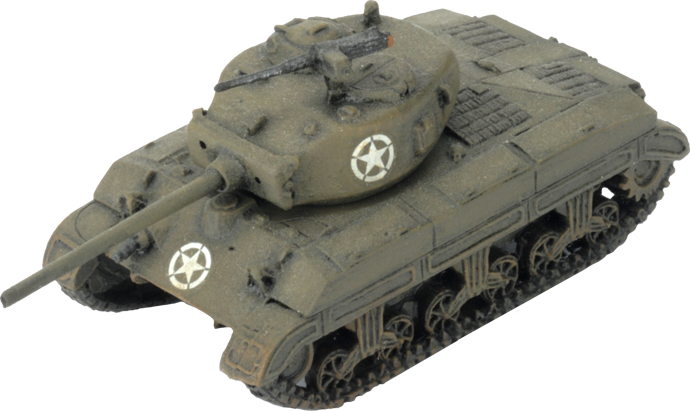
|
The M27 in North Africa
with Ryan Jeffares
With the release of the North Africa compilation and the introduction of the wildcard slot, there are several new vehicles which will soon be gracing our gaming tables. In this article I’ll examine one of the new offerings for the Americans, the M27 tank, exploring the historical background of this prototype vehicle, its statistics in game as well as tactics for its use along with some sample army lists.
|
|
History
In 1942, shortly after the M4 Sherman entered service, the US Ordnance Department began a programme to find a potential replacement. This effort would start with the T20, which was powered by a Ford V8 engine and used a horizontal volute suspension as well as a hydramatic transmission which was also used in the M5 Stuart. The T20 was armed with a 76mm gun, while the T20E1 and E2 were armed a with 75mm automatic gun, and 3-inch gun respectively. This pattern continued throughout the iterative development cycle, with the E1 and E2 variants of the T22 and T23 sharing the same armaments found on the T20E1 and T20E2.
|
|
In October of 1942, Chrysler began to build the T22, which was identical to the T20, apart from its transmission, which was replaced with the transmission found on the M4 Sherman, but on the T22 it was used in a rear-wheel-drive configuration instead. The T23 which followed was constructed at Detroit Arsenal, and differed from the previous models in having vertical volute suspension and unusually, an electric transmission, built by General Electric. The T23 was somewhat successful as a protype and 250 of them were ordered in May 1943, although they would not be accepted for service as the M27 due to issues with weight distribution and the concerns about the reliability of an electric transmission. However, the cancellation of the T-23 led to another period of development, through the T25 and T26, eventually culminating in the M26 Pershing, which would see combat service in 1945.
|
|
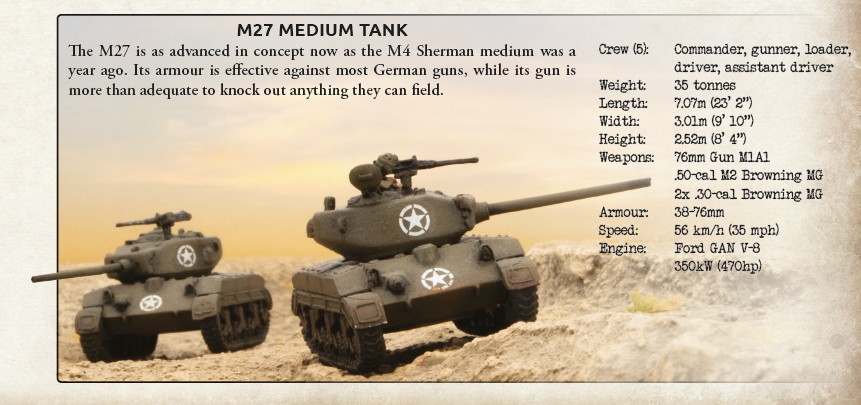
|
|
It is hypothetically possible that the T23 could have been accepted and seen service, if the ability for a medium tank to mount a 76mm had been viewed as crucial necessity due to the appearance of new German tanks like the Tiger.
|
|
Statistics
Compared to the Sherman it was intended to replace, the M27 has 1 more armour on its front and side, giving it fair protection against the tanks such as Panzer IVs, Shermans or T-34s. However, with these tanks having been rushed into service, their crews were no better trained than their counterparts in the M4, leaving them Trained, Green and Aggressive. One of the most standout features of the M27 is its stabilised 76mm gun, as it can reliably destroy most medium tanks from the front, while retaining a high rate of fire on the move. It is slightly faster at a dash than the Sherman, though its 76mm gun does lack HE and smoke, losing out in utility to the 75mm of the Sherman.
|
Tactics
The M27 may seem like a big step up from the Sherman in terms of armament and armour, but this is somewhat of an illusion, as the extra point of armour offers only slight protection against AT 12 guns like the Pak 40 or even other 3 inch or 76mm guns. Even heavier weapons like the Italian 90mm and the German 88mm will make a mockery of the M27 and at that point you’d be better off with having taken more Shermans instead. If you are running M27s in a whole formation, you need to plan accordingly on how to deal with heavy anti-tank guns and this will inform your list construction. |
|
While the M27 doesn’t have the armour to ignore anti-tank gun fire, it is incredibly fast, and this can be used to your advantage. For starters, when using the battle plans, I’d recommend almost always selecting manoeuvre, as it will generally force your opponent into missions where they will have to move their anti tank guns in order to cover the objectives, lessening their firepower and leaving them vulnerable while not dug in. Furthermore, there will be cases when you have to assault an objective covered by guns or move into their line of sight, in this instance, I’d recommend including at least one, but preferably two (or even more) units of artillery, which can help clear out dug in guns or lay smoke to cover a move into the open.
|
|
The other standard good practices apply here, when you need to assault a position with M27s, mass them, and concentrate on a single objective, as this limits how much of the enemy force can hit you. Furthermore, infantry is a great tool for clearing out objectives, especially if they’re bristling with anti-tank guns.
|
|
So far, I’ve talked to you about how to try and mitigate the weaknesses of the M27, but what about its strengths? To be frank, the M27 is an excellent medium tank killer, with AT 12 being enough to almost guarantee that Shermans, T-34s and Panzers will be destroyed if hit. In engagements against enemy tanks, use the mobility of the M27 to get into concealing terrain as soon as possible, preferably at range, as your aggressive rating makes you excessively easy to hit and this needs to be mitigated as much as possible. Don’t be afraid to force a long range engagement against medium tanks, while they’ll be harder to hit too, they will struggle to penetrate you even when they hit. Savvy opponents will most likely realise that a gunnery duel between M27s and Panzer IVs at range will probably not go well and will try to flank you, as your side armour is significantly easier to penetrate and can even be penetrated by light tanks. Infantry can also help in this situation, as they can help screen the flanks of your tanks, forcing your opponent to target them before they can move up for flanking shots.
|
|
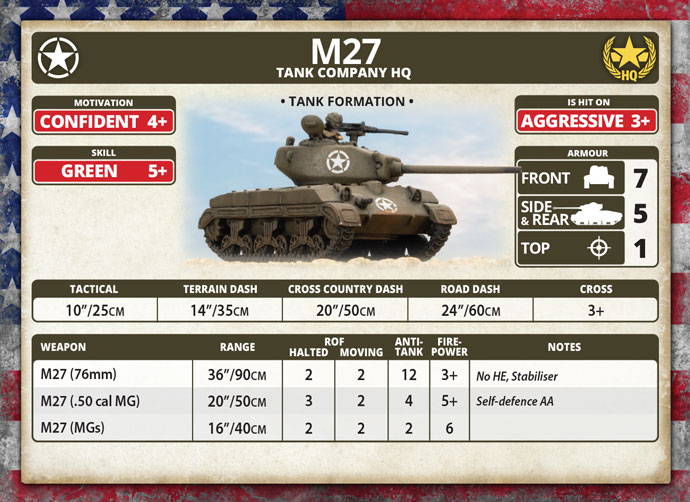
|
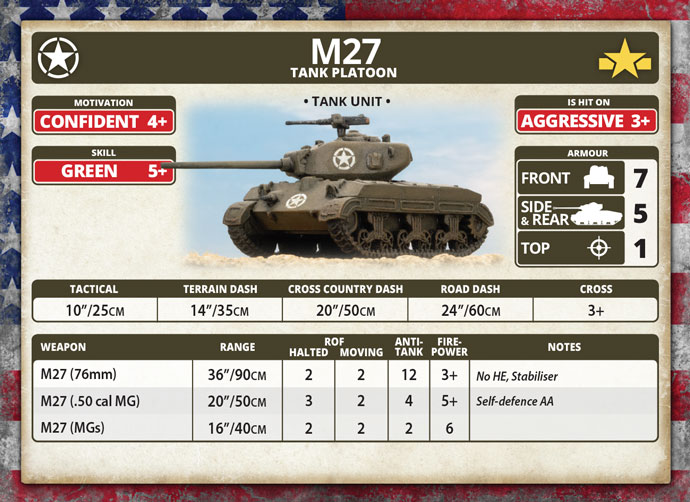 |
|
Against enemy heavy armour, you shouldn’t try to take head on engagements unless forced to by the nature of the terrain, deployment or in a truly desperate situation, the M27 may be powerful, but it will struggle to reliably kill a Tiger from the front. Dash your tanks forwards making the best use of cover (and/or smoke) as you can, gunning for their side armour. Also, with regards to the stabiliser, be pragmatic, you might have a long range concealed shot on a Tiger’s side armour, but hitting on a 7+ with the stabiliser is probably not a risk worth taking, especially when you take return fire into account. It’s often better to forgo shots and get to a more advantageous position from which you can move out next turn to deliver a coup de grace. And of course, those Tigers can’t be everywhere, they’re points intensive and generally not taken in large numbers, so just attack the objectives where they aren’t. On the defensive, just let you infantry sit on the objectives and hold your tanks out of sight or in the best cover you can manage, after all a tiger doesn’t earn its points by machine gunning infantry. Bide your moment to strike and hit its flanks, but remember, the objectives are what counts, if you hold them at the end of the game, it doesn’t matter how many of your shiny M27s are burning wrecks.
|
|
Army Lists
|
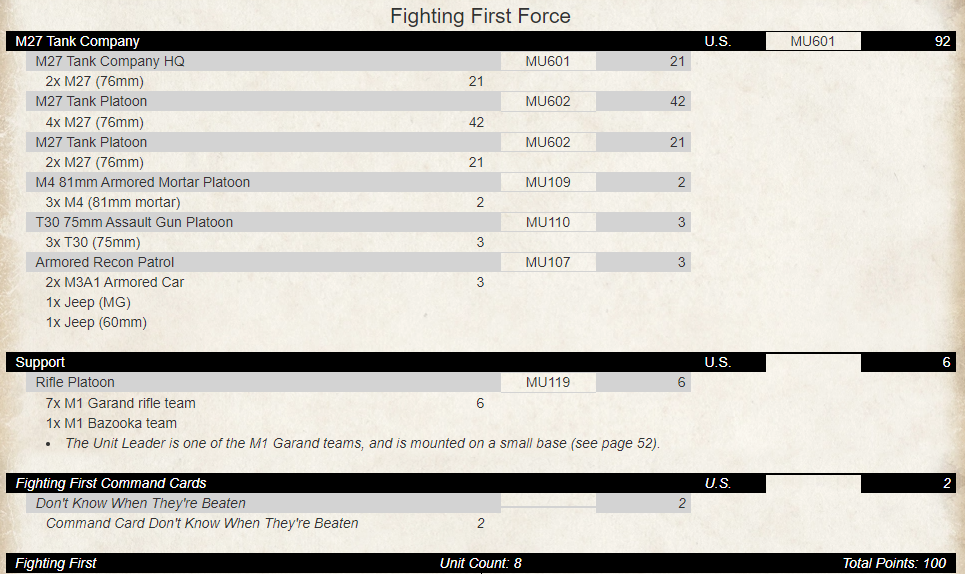 |
|
This list is an example of how you could put the above advice into practice, as it has all the fundamental elements which are key to helping make M27s a potent threat on the battlefield. The T30s and Mortars provide the necessary artillery to destroy guns and infantry while the recon patrol allows the M27s to get into favourable positions before the battle starts. The rifle platoon was the only infantry I could fit into the list, but there is the possibility of running only 5 or 6 M27s and making the infantry a full formation instead. I stacked one platoon of M27s to be 4 strong as at 42 points it’s an ideal unit to fufill the 40% of reserves, in case the mission ends up involving them. The other two platoons being 2 tanks strong was a conscious decision to allow the M27s to better spread out their firepower, though it would be down to personal preference whether to run an HQ with a single tank and a platoon with 3 instead.
|
|
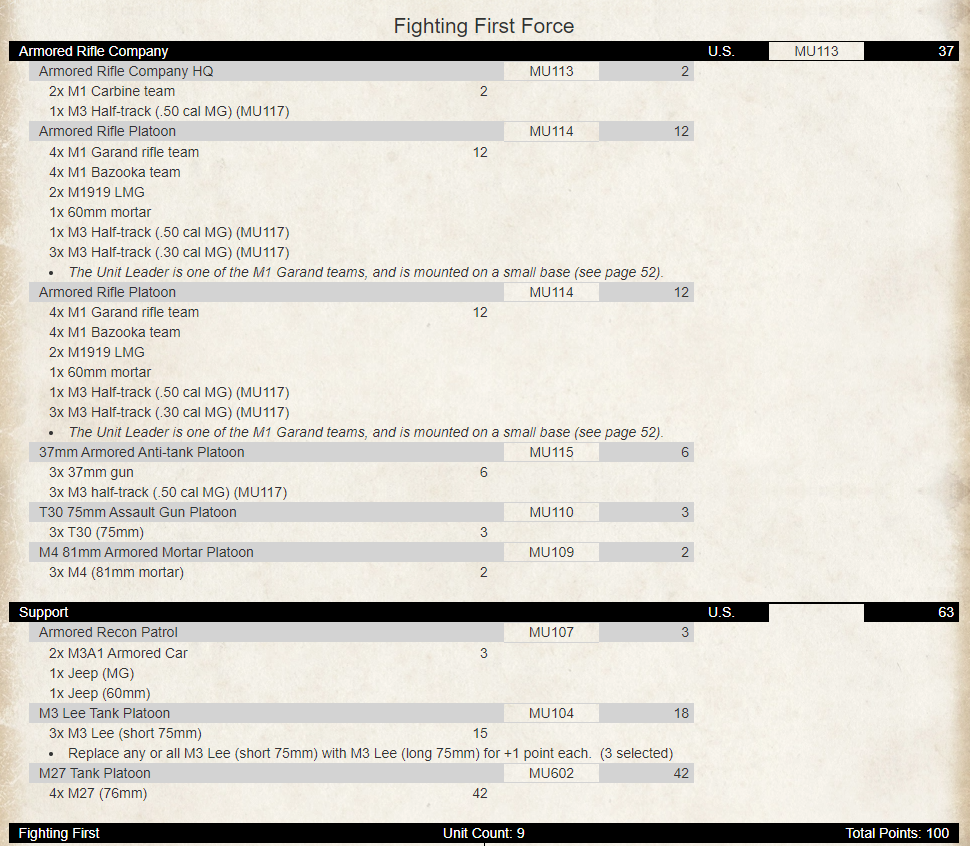
|
|
This list illustrates an example of a list where the M27s play a supporting role to another formation, providing a large unit which can have a large impact on the game and monopolise my reserves. The Armored Rifle company is designed to be able to hold its own on the defence, relying on the Lees to thin out enemy armour until the M27s arrive, with the bazookas and 37mms as a backstop to buy time against tank assaults. Once again, the two units of artillery feature, as these are key to eliminating threats to both the infantry and tanks, while the recon can help get the halftracks and tanks into position in more mobile battles.
With this you should have some inspiration for how to get the M27 Tank into your next games.
~Ryan
|
|
|